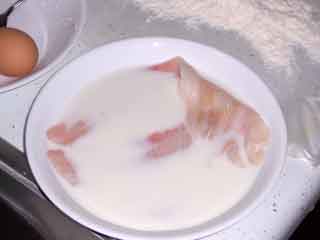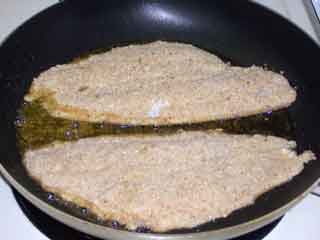When I was a kid, beef stew always meant fat and gristle; I hated it. By the time I was in High school, Dinty Moore's had come along, and that I learned to like, though probably just because, like most prepared foods, it had enough salt in it to pickle an entire steer. In any case, I didn't experiment with beef stew again until well into my cooking experience. I think it was one of those 'mother of invention' deals - a camping trip with about 18 mouths to feed, including large adults and a horde of hungry kids. A bucket of stew sitting on the campfire seemed the way to go.
This is one of those 'couldn't possibly be easier' meals where the success of the dish is a function of attitude rather than culinary legerdemain. So, with only a couple of photos for reference, set your mind to 'plain, simple, natural,' and dive in . . .
here's what you'll need . . .
steak or a roast, not stew beef, about 1/3 lb per serving
carrots, at least one per serving
onion, about ½ per serving
celery, about ½ rib per serving
potatoes, at least one per serving, peeled if you must
tomatoes, one 14 oz. can per two servings or one fresh tomato per serving
turnip (or more typically, rutabaga), depends on size, two or three chunks per serving
red & green bell peppers, same as turnip two or three chunks of each per serving
mushrooms, 4 per serving
garlic (optional), one clove per lb. to flavor the meat, and/or a skewer-full to flavor the stew
green beans, wax beans, zucchini, summer squash, and/or other favorites
maybe a handful of ripe olives
white wine
water
1 or 2 bay leaves
salt
Tellicherry
Here's how you do it.
Buy a good quality roast or a steak, or three for your meat. Any cut of round will do nicely. Chuck steak will work, but only if you can find a really lean piece. Sirloins are OK, but tend to toughen up with the prolonged cooking of a stew. Tenderloins and filets will work, but it does seem a tad criminal to serve them in a stew.
Stay away from the prepackaged stew beef at your market, unless you know the butcher personally. Mostly, you'll never know what cut(s) of meat you're getting; you'll only be getting the scraps that were trimmed from something salable; it's always cut in chunks too large; and it may be several days old by the time they've got enough to shrink-wrap and put it out as stew beef. It only takes an extra few minutes for you to cut your own chunks. Invest the time.
Cut your steak into bite size chunks. Beef stew should be like Japanese food - no knife required (if a guest must cut a piece of food, the chef must commit seppuku!)
When your meat is all chunked, season it liberally with fresh ground Tellicherry. Use your fingers or the back of a spoon to gently tap the pepper into the surface of the meat, and then let it sit for 15 minutes or so before starting the cooking. Do not flour the meat!
While the meat is resting, whack up your other vegetables (except the turnip and potato, unless you want to keep them covered with cold water until it's time to toss them in - otherwise, they'll turn black and ugly!) Use the same bite-sized mindset that you held for your steak for everything in your stew, and you will be praised at the table (or log, if you're doing this over a campfire in the woods!)
So, dig out the stewpot, and get it hot. Pour a Tbsp. or two of olive oil into the hot pot (you want enough to roll around the bottom of the pan, but not enough for any 'depth'). If you wish, smash a clove of garlic with the side of your knife, remove the peel and toss the garlic into the hot oil. Move it around for a minute or so, just until it starts to brown, and then discard it. Toss in the meat. Watch out for the spits, and shake, swirl, stir, push to quickly sear the meat on all sides. You don't want to cook it, just to seal in the juices.
At this point, I like to add the mushroom chunks to the pot and cook them just long enough that they're about ready to give up their juices, about a minute - no more than two. You don't want them to actually start to give up the juices because the pan is hot enough that most of the juice will evaporate, and I like to incorporate it into the 'wholeness of the stew.' But I also like the way the mushrooms pick up some flavor from the hot pan. Or, you can just toss the mushrooms in later - you're choice, both good.
Now you need some liquid. Start with the white wine - a goodly slug into the bottom of the pan to deglaze it and cool it down a little. Give the bottom of the pan a scrape or two to loosen anything that's stuck, and swirl it all around. Let it bubble for a minute or three to cook off the alcohol.
If you're going to use fresh tomatoes, add some water now and put your tomatoes in later. But if you're using canned tomatoes, toss them in next, along with all their packing juices - liquid, you know - and stir everything around.
If you didn't do it before, cut up your potatoes and turnip. Always peel the turnip; only peel the potatoes if you must (for some unknowable aesthetic purpose). And, remember, bite size pieces . . .
Now toss everything in. If you're using any other canned vegetables (beans for example), be sure to add their packing juices as well. Add enough water to cover the contents of the pot to a depth of at least an inch - three would be better. Give a goodly grind of Tellicherry over the top surface, and add a little salt. If you've used any canned vegetables, make that a very little salt - there's already tons of it in those packing juices. Assuming you've got 4 - 6 servings of stew going, think in terms of maybe 1 tsp. of salt. Start with that in the palm of your hand and add a pinch to the pot for each potato and one pinch for all the turnip, and maybe one more pinch for the rest of the pot. If you've got any salt left, set it aside - you can add it later after you taste-test your creation.

If you wish, stick a skewer-full of garlic into the liquid to flavor the pot while it cooks. How many cloves depends on your tastes (and do peel them!). And keep in mind that if you already used garlic to flavor the meat, this will amplify that flavor. Usually, I'll do one or the other but not both. And if I do the skewer thing, I'll use one clove per serving, up to six - that's plenty for any sized batch. Don't break the bay leaves, just toss them in whole - they'll be easier to find and remove when you serve your stew.
So, turn the heat down to a gentle simmer, cover and cook for about 45 minutes. Get out your spoon, scoop up a piece of potato and some broth, let it cool way down, and taste it! If need be, add some more salt and/or pepper, and remove the garlic skewer if you used it (after all, enough is enough). Cover the pot and cook some more. It should be good in another 45 minutes or so, and it will continue to be good for the next three or four hours. If you need to wait longer than four hours, turn it off now and turn it back on an hour before serving.




























